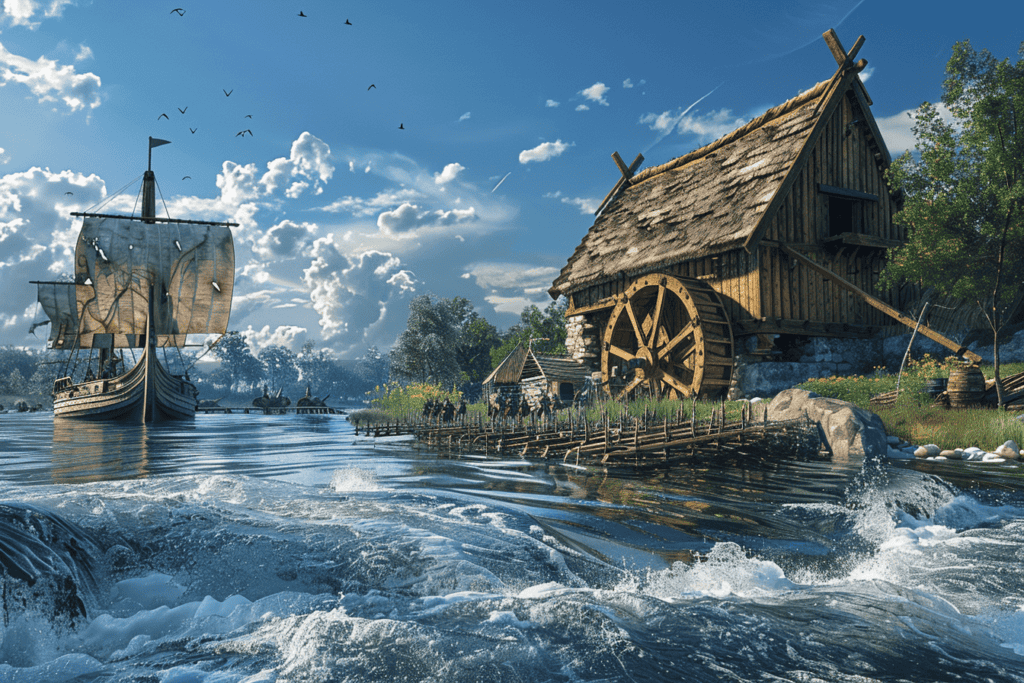The Vikings, known for their seafaring prowess, also made significant advancements in agricultural technology, particularly in the use of water mills.
By introducing horizontal waterwheels and enhancing structural designs with durable materials, they optimized grain grinding efficiency.
These improvements boosted agricultural productivity, supported larger populations, and facilitated trade, showcasing the Vikings’ innovative engineering skills and their lasting impact on society.

These mills were powered by the force of moving water, which turned a wheel that was connected to a grinding stone.
Harnessing the power of water was not a new concept, but the Vikings took it to a whole new level.
They built mills that were more efficient and effective than any that had come before, and they used them to produce large quantities of flour that could be used to make bread, porridge, and other staples of their diet. The mills were also used to grind other materials, such as bark, for use in tanning leather.
The Viking water mills were an important part of their society, providing a reliable source of food and other materials.
They were also a testament to the ingenuity and resourcefulness of the Vikings, who were able to use the power of nature to improve their lives in ways that were both practical and innovative.
The History Of Water Mills – From Ancient Innovations to Medieval Technology

Water mills have been around for thousands of years, with the earliest known use of water power dating back to ancient Greece and Rome.
These early water mills were used mainly for grinding grains and were powered by simple water wheels. Over time, the technology evolved, and the water mills became more complex and efficient.
During the Middle Ages, water mills became an integral part of medieval society, and their use spread rapidly throughout Europe.
The Vikings, in particular, were known for their ingenious water mills, which they used to grind grains and power other machinery.
Water mills continued to evolve throughout the medieval period, with new designs and innovations being introduced regularly.
By the end of the Middle Ages, water mills had become an essential part of daily life, and their use was widespread across Europe.
The Domesday Book and Water Mills in England
The Domesday Book, which was commissioned by William the Conqueror in 1086, provides a detailed record of the water mills that were in use in England at the time.
According to the book, there were over 5,000 water mills in England, which were used for a variety of purposes, including grinding grains, sawing timber, and processing textiles.
Water mills continued to be an essential part of English society throughout the medieval period, and their use continued to spread. By the 16th century, water mills had become so widespread that there was hardly a village or town in England that did not have one.
The Science and Engineering Behind Water Mills

Water mills were an ingenious invention that revolutionized the way grain was ground during the Viking era.
The waterwheel is the most important component of a water mill. It is responsible for harnessing the power of water to turn the millstones that grind grain. The waterwheel is made up of several parts, including the paddles, the shaft, and the gears.
The paddles are the part of the waterwheel that catches the water and turns the wheel. They are angled in such a way that the force of the water pushes them around in a circle. The shaft is the part of the waterwheel that connects the paddles to the gears.
The gears are responsible for transferring the power from the waterwheel to the millstones.
The design of the waterwheel is crucial to its efficiency. The size and shape of the paddles, as well as the angle at which they are set, can all affect the amount of power that can be harnessed from the water. The efficiency of the waterwheel can also be affected by the design of the millstones.
Viking Innovations in Water Mill Technology

The Vikings were adept at adapting and improving existing technologies to suit their needs. When it came to water mills, they applied their engineering skills to enhance efficiency and reliability.
One significant improvement was the introduction of the horizontal waterwheel. Unlike the more common vertical wheels, horizontal waterwheels could be placed directly in fast-flowing streams, eliminating the need for complex gearing systems.
This design allowed the mills to operate in a wider variety of locations, especially in the rugged terrains of Scandinavia where streams were abundant but flat, slow-moving rivers were rare.
How Did The Vikings Improve The Water Mill Structures?
In addition to the horizontal waterwheel, Vikings improved the structural design of water mills to withstand harsh Northern European climates. They constructed mills using durable materials like timber and stone, ensuring longevity and resistance to the elements.
The buildings were often reinforced with wooden beams and placed on sturdy foundations to prevent damage from floods and ice.
The Vikings also optimized the placement of millstones and gears to maximize the efficiency of the grinding process.
By carefully calibrating the distance between the stones and ensuring a consistent water flow, they were able to produce finer flour more quickly than previous designs allowed.
How Did These Water Mills Impact Viking Society?
The Viking improvements to water mills had profound effects on their society. The increased efficiency of these mills significantly boosted agricultural productivity, allowing for surplus grain production.
This surplus supported larger populations and facilitated trade both within and outside Viking territories.
The ability to quickly and efficiently grind grain also freed up labor, enabling more community members to engage in other productive activities such as crafting, trading, and expanding settlements.
These advancements not only improved daily life but also contributed to the Vikings’ economic stability and growth, cementing their reputation as both formidable warriors and skilled engineers.
These improvements showcase the Vikings’ ability to adapt and innovate, ensuring their technologies were not only effective but also sustainable and adaptable to various environments.










Add Comment